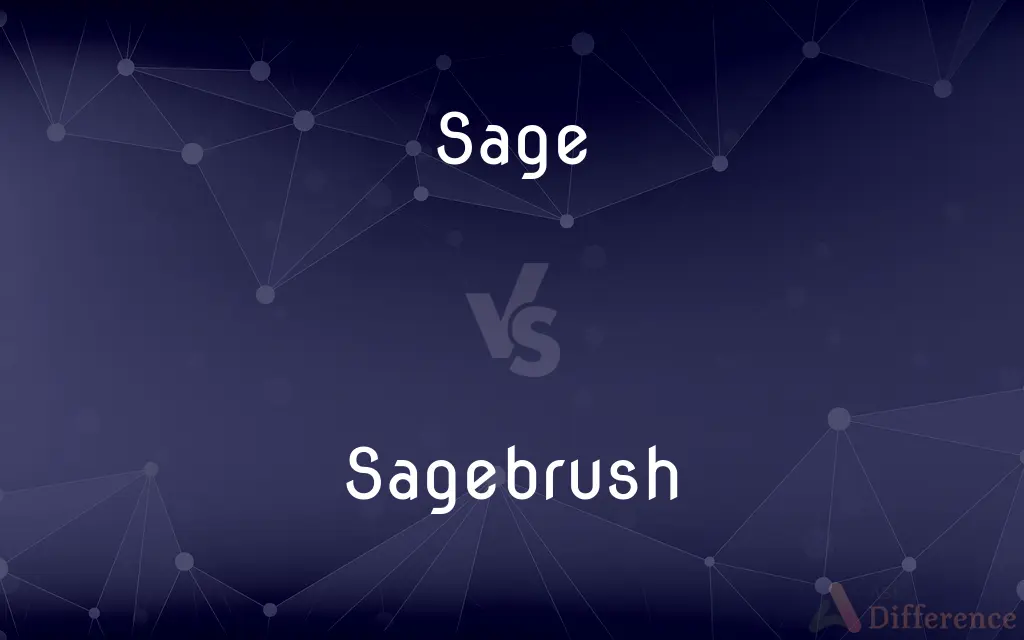Sage vs. Sagebrush — What's the Difference?
By Tayyaba Rehman & Urooj Arif — Updated on May 6, 2024
Sage is a culinary herb known for its aromatic leaves, used in cooking and traditional medicine, while sagebrush refers to wild shrubs found in arid regions, known for their medicinal and ecological importance.

Difference Between Sage and Sagebrush
Table of Contents
ADVERTISEMENT
Key Differences
Sage (Salvia officinalis) is a perennial, evergreen herb with greyish leaves and a strong aroma, commonly used in cooking. It belongs to the mint family, Lamiaceae. On the other hand, sagebrush, primarily the genus Artemisia, includes many species of shrubs that thrive in North American deserts and have a distinct, pungent smell.
Culinary sage is prized for its aromatic leaves that are used fresh or dried in various dishes, particularly in European cuisines. It is also known for its health benefits, including anti-inflammatory and antioxidant properties. In contrast, sagebrush is not typically used for cooking but holds significant medicinal value among indigenous peoples, including use as a remedy for colds and headaches.
The leaves of sage are soft and edible, often featured in stuffing, sausages, and sauces. Whereas, sagebrush plants are woody, with small, hard leaves adapted to dry environments, making them unsuitable for culinary applications but important for habitat conservation and soil stabilization.
Sage plants are commonly cultivated in gardens and pots for their culinary use and attractive flowers, which attract pollinators like bees. Sagebrush, while sometimes considered a nuisance in large numbers, plays a crucial ecological role, providing habitat and food for wildlife in arid regions.
The harvesting and preparation of sage involve picking the leaves, which can be used directly in cooking or dried for later use. Meanwhile, sagebrush is typically harvested for its branches and leaves for use in traditional herbal remedies and crafts, such as basket weaving.
ADVERTISEMENT
Comparison Chart
Scientific Family
Lamiaceae (mint family)
Asteraceae (daisy family)
Common Use
Culinary herb in cooking
Medicinal and ecological applications
Plant Type
Herbaceous perennial
Woody shrubs
Leaf Texture
Soft and edible
Hard and not typically edible
Ecological Role
Attracts pollinators
Provides wildlife habitat
Compare with Definitions
Sage
A garden plant that attracts bees and butterflies with its flowers.
Planting sage in the garden can help support local bee populations.
Sagebrush
A plant used in traditional indigenous medicine.
Sagebrush tea has been used to treat colds and headaches.
Sage
A perennial plant often used for its medicinal properties.
Sage tea is reputed to help soothe sore throats.
Sagebrush
An essential part of the ecosystem, supporting numerous wildlife species.
Sagebrush provides necessary cover for sage-grouse.
Sage
A natural remedy with antioxidant and anti-inflammatory effects.
Sage extracts are often found in natural health products.
Sagebrush
Used in crafts and herbal remedies by Native American cultures.
Sagebrush branches are traditionally used in basket making.
Sage
An aromatic culinary herb known for its grayish leaves and woody stems.
Sage is a popular herb in Thanksgiving stuffing.
Sagebrush
A shrub native to North American arid regions, known for its hardy nature.
Sagebrush covers vast areas of the Great Basin desert.
Sage
A traditional herb in European and Mediterranean cuisine.
Fresh sage leaves are essential in Italian saltimbocca.
Sagebrush
Not suitable for culinary use due to its bitter taste.
Unlike culinary sage, sagebrush is not used in cooking.
Sage
One venerated for experience, judgment, and wisdom.
Sagebrush
Sagebrush is the common name of several woody and herbaceous species of plants in the genus Artemisia. The best known sagebrush is the shrub Artemisia tridentata.
Sage
Any of various plants of the genus Salvia of the mint family, especially S. officinalis, having aromatic grayish-green leaves.
Sagebrush
Any of several aromatic plants of the genus Artemisia of the composite family, especially A. tridentata, a shrub of arid regions of western North America, having silver-green leaves and large clusters of small white flower heads.
Sage
The leaves of S. officinalis used as a seasoning.
Sagebrush
An area dominated by sagebrush.
Sage
Any of various similar or related plants, chiefly in the mint family.
Sagebrush
Any of several North American aromatic shrubs of the genus Artemisia, having silvery-grey, green leaves.
Sage
Sagebrush.
Sagebrush
A low irregular shrub (Artemisia tridentata), of the order Compositæ, covering vast tracts of the dry alkaline regions of the American plains; - called also sagebush, and wild sage.
Sage
Having or exhibiting wisdom and calm judgment.
Sagebrush
Any of several North American composite subshrubs of the genera Artemis or Seriphidium
Sage
Proceeding from or marked by wisdom and calm judgment
Sage advice.
Sage
(Archaic) Serious; solemn.
Sage
Wise.
Sage
(obsolete) grave; serious; solemn
Sage
A wise person or spiritual teacher; someone of gravity and wisdom, especially, a teacher venerable for years, and of sound judgment and prudence; a grave or stoic philosopher.
Sage
The plant Salvia officinalis and savory spice produced from it; also planted for ornamental purposes.
Sage
Any plant in the genus Salvia
Sage
Any of a number of plants such as sagebrush considered to be similar to Salvia officinalis, mostly because they are small shrubs and have gray foliage or are aromatic.
Sage
(Internet slang) Word used in the email field of imageboards to prevent a bump of the post. Used as an option rather than a word in some imageboard software.
Sage in all fields
Sage
(Internet slang) The act of using the word or option sage in the email field or a checkbox of an imageboard when posting a reply.
Reminder to sage and report.
Sage
A suffruticose labiate plant (Salvia officinalis) with grayish green foliage, much used in flavoring meats, etc. The name is often extended to the whole genus, of which many species are cultivated for ornament, as the scarlet sage, and Mexican red and blue sage.
Sage
A wise man; a man of gravity and wisdom; especially, a man venerable for years, and of sound judgment and prudence; a grave philosopher.
At his birth a star,Unseen before in heaven, proclaims him come,And guides the Eastern sages.
Sage
Having nice discernment and powers of judging; prudent; grave; sagacious.
All you sage counselors, hence!
Sage
Proceeding from wisdom; well judged; shrewd; well adapted to the purpose.
Commanders, who, cloaking their fear under show of sage advice, counseled the general to retreat.
Sage
Grave; serious; solemn.
Sage
A mentor in spiritual and philosophical topics who is renowned for profound wisdom
Sage
Aromatic fresh or dried gray-green leaves used widely as seasoning for meats and fowl and game etc
Sage
Any of various plants of the genus Salvia; a cosmopolitan herb
Sage
Having wisdom that comes with age and experience
Sage
Of the gray-green color of sage leaves
Common Curiosities
Can sagebrush be used in cooking?
No, sagebrush is generally not used in cooking due to its bitter taste and hard leaves.
What are the primary uses of sage?
Sage is primarily used as a culinary herb and in traditional medicine for its health benefits.
What ecological role does sagebrush play?
Sagebrush is crucial for providing habitat and food for wildlife in arid ecosystems.
Where can sage be grown?
Sage can be grown in most temperate climates and is often found in herb gardens.
How do the medicinal properties of sage and sagebrush differ?
Sage is used for its anti-inflammatory and antioxidant properties, whereas sagebrush is traditionally used to treat respiratory ailments and pains.
What wildlife depends on sagebrush?
Wildlife such as the sage-grouse heavily depend on sagebrush for shelter and food.
Is sagebrush ever considered invasive?
Sagebrush is not typically considered invasive but can dominate landscapes where conditions suppress other plant growth.
Are sage and sagebrush related?
No, despite the similar names, sage and sagebrush belong to different plant families and have different uses and characteristics.
Can sagebrush be used in home decor?
Yes, sagebrush can be used in home decor, particularly in natural and rustic-themed arrangements.
How can sage be preserved for culinary use?
Sage leaves can be dried or frozen to preserve their flavor for culinary use.
How does sage contribute to biodiversity?
Sage attracts pollinators such as bees and butterflies, enhancing garden biodiversity.
What are the traditional uses of sagebrush by indigenous peoples?
Sagebrush has been used in various traditional remedies, including teas and topical applications for pain relief.
What are the best conditions for growing sage?
Sage thrives in well-drained soil with plenty of sunlight.
Can both sage and sagebrush be used in landscaping?
Yes, both can be used in landscaping, sage for culinary and ornamental purposes, and sagebrush for xeriscaping and native plant gardens.
What part of the sage plant is used in cooking?
The leaves of the sage plant are used in cooking.
Share Your Discovery

Previous Comparison
Act vs. Play
Next Comparison
Rumba vs. RhumbaAuthor Spotlight
Written by
Tayyaba RehmanTayyaba Rehman is a distinguished writer, currently serving as a primary contributor to askdifference.com. As a researcher in semantics and etymology, Tayyaba's passion for the complexity of languages and their distinctions has found a perfect home on the platform. Tayyaba delves into the intricacies of language, distinguishing between commonly confused words and phrases, thereby providing clarity for readers worldwide.
Co-written by
Urooj ArifUrooj is a skilled content writer at Ask Difference, known for her exceptional ability to simplify complex topics into engaging and informative content. With a passion for research and a flair for clear, concise writing, she consistently delivers articles that resonate with our diverse audience.
















































